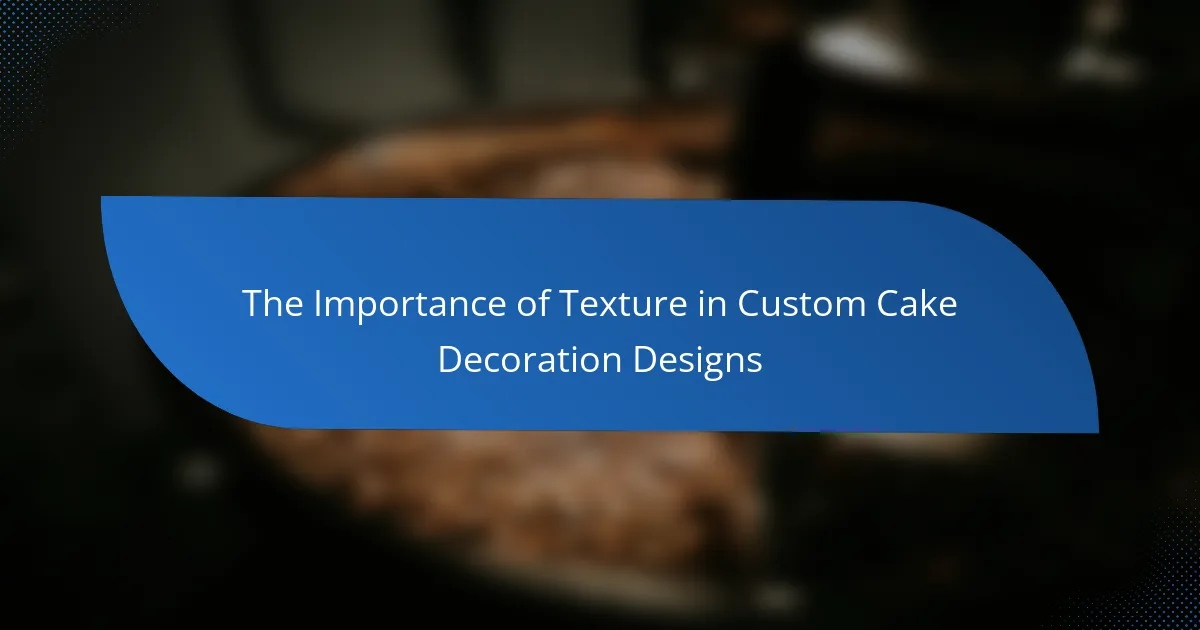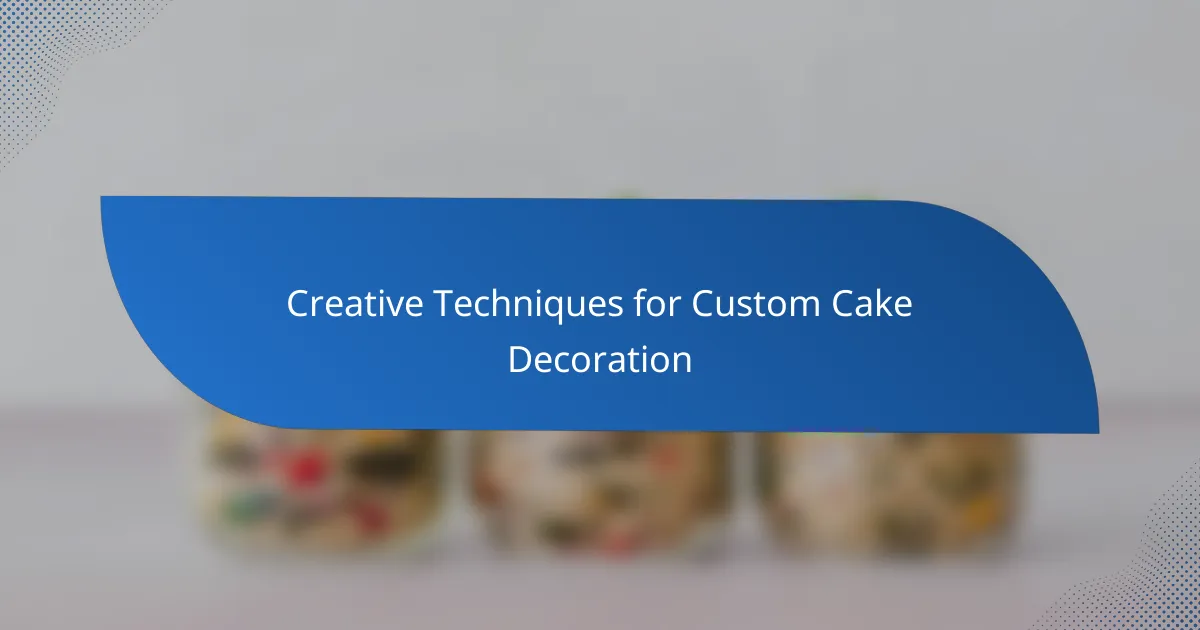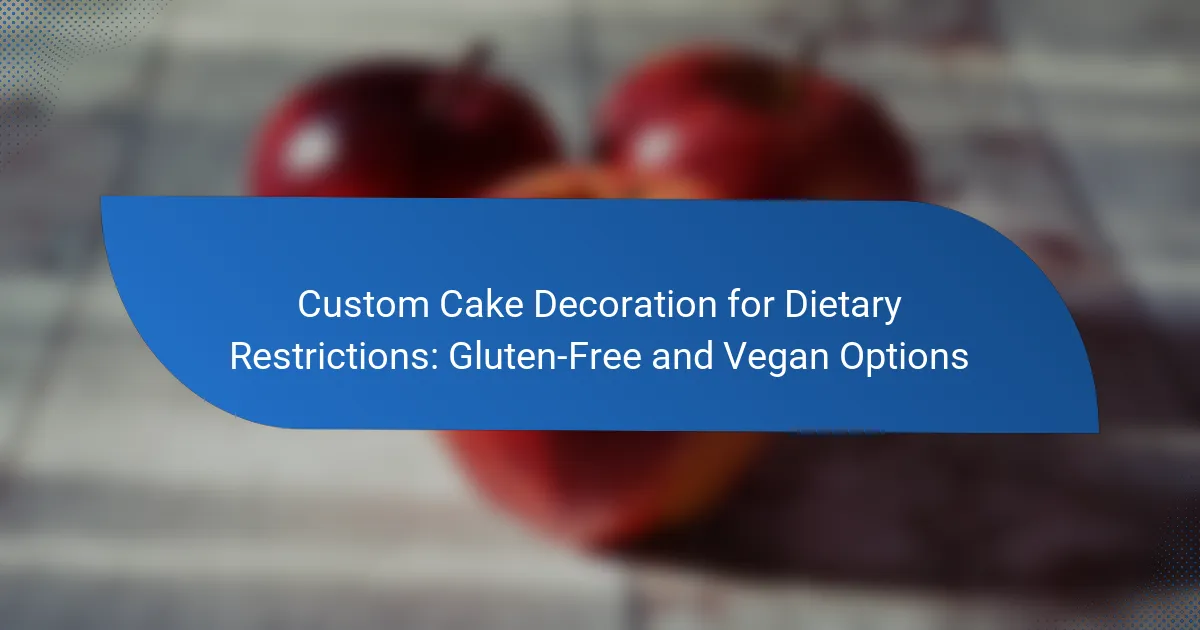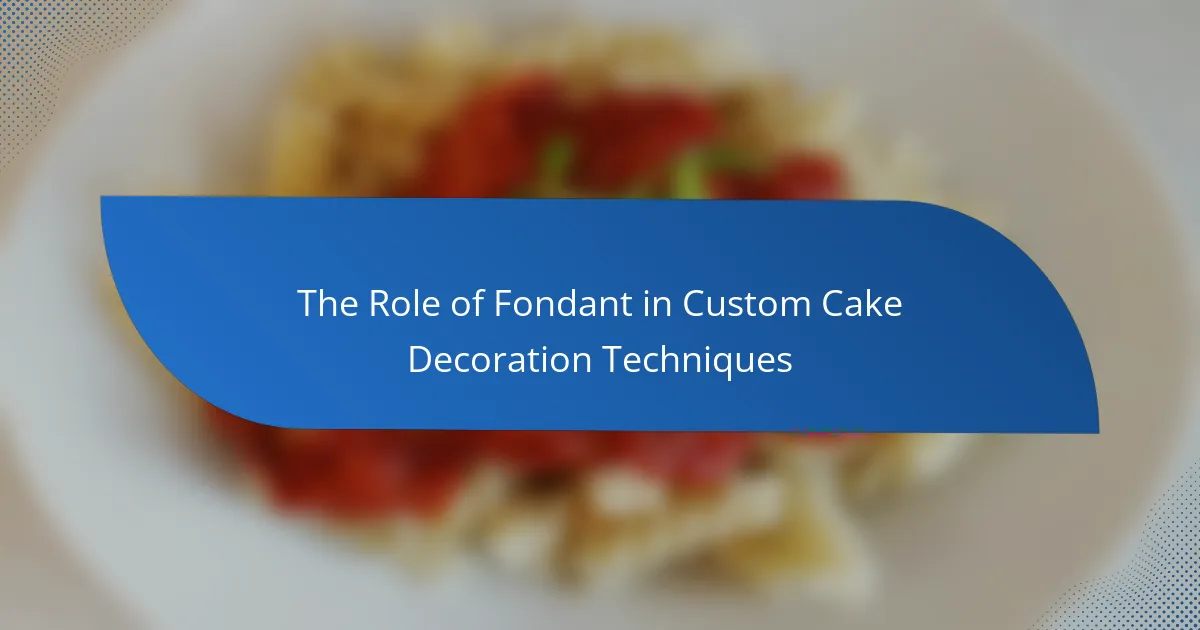Custom cake decoration is the process of designing and embellishing cakes to create personalized and visually appealing desserts. This article provides a comprehensive step-by-step guide for beginners, covering essential tools and materials, basic techniques, and advanced methods such as airbrushing and fondant sculpting. Readers will learn about the importance of practice, the use of various icing types, and the exploration of online resources for skill enhancement. Additionally, the guide emphasizes the growing demand for unique cake designs and the community support available for aspiring bakers.
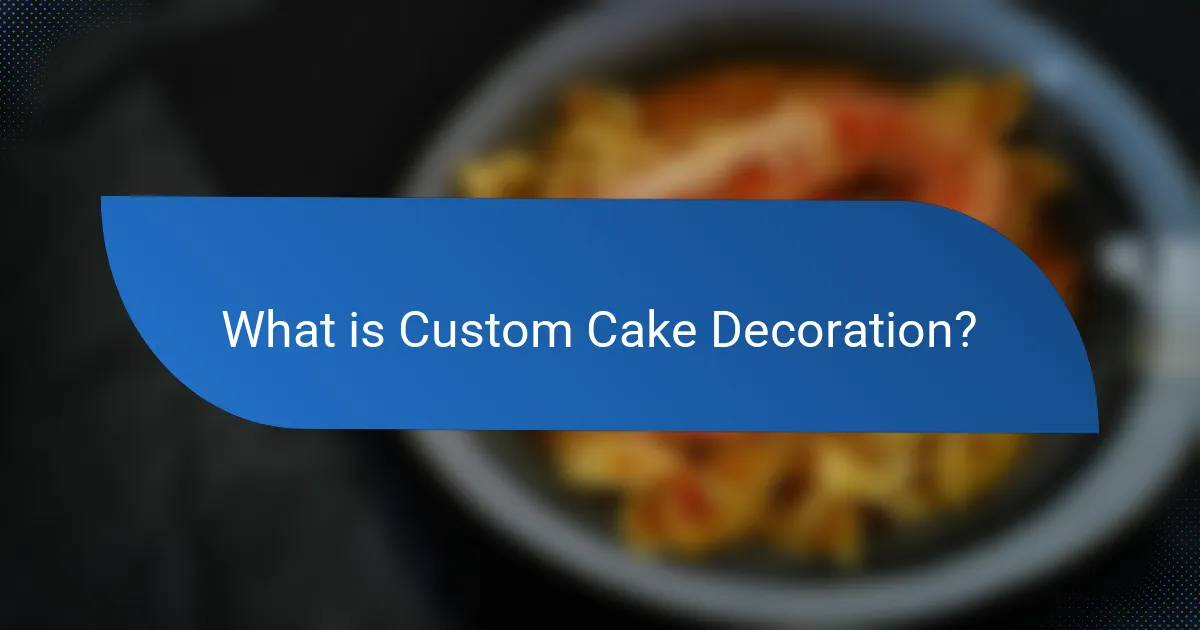
What is Custom Cake Decoration?
Custom cake decoration is the art of designing and embellishing cakes to create visually appealing and personalized desserts. This process involves using various techniques and materials such as fondant, buttercream, and edible decorations. Custom cake decoration allows for creativity and personalization, making cakes suitable for specific occasions like birthdays, weddings, or anniversaries. Many bakers and decorators learn these skills through practice and tutorials, enhancing their ability to create intricate designs. The demand for custom cakes has increased, with a growing market for unique and themed cake designs.
How did custom cake decoration evolve over time?
Custom cake decoration has evolved significantly from simple designs to intricate artistry. Initially, cakes were decorated minimally, often with basic icing and simple shapes. In the 17th century, royal icing became popular, allowing for more detailed designs. The introduction of fondant in the 19th century revolutionized cake decoration, enabling smooth finishes and elaborate decorations. The 20th century saw the rise of cake decorating as an art form, with the advent of specialized tools and techniques. Today, custom cake decoration incorporates various styles, including sculpted cakes and edible printing. The evolution reflects cultural trends and advancements in baking technology, making it accessible to home bakers and professionals alike.
What cultural influences shaped custom cake decoration styles?
Cultural influences that shaped custom cake decoration styles include various global traditions and artistic movements. For instance, French patisserie techniques emphasize elegance and refinement in cake design. The use of fondant and intricate piping is rooted in these traditions. Similarly, the Japanese art of wagashi showcases seasonal themes and natural aesthetics in cake decoration. This influence promotes a minimalist approach and attention to detail. Additionally, Mexican Día de los Muertos celebrations inspire vibrant colors and sugar skull designs. These elements reflect cultural storytelling through cake decoration. Overall, these diverse influences create a rich tapestry of styles in custom cake decoration.
What are the key milestones in the history of cake decoration?
The key milestones in the history of cake decoration include the introduction of royal icing in the 16th century. This technique allowed for intricate designs and decorations on cakes. In the 19th century, the invention of the first piping bag revolutionized cake decoration. It enabled decorators to create detailed designs with ease. The late 19th century saw the rise of fondant, which provided a smooth finish for cakes. In the 20th century, the popularity of cake decorating shows and competitions increased. This led to greater public interest and innovation in cake designs. The introduction of ready-to-use decorating supplies in the late 20th century made cake decoration accessible to home bakers. Today, cake decoration continues to evolve with trends like edible images and 3D cake designs.
What are the essential tools and materials for beginners?
Essential tools and materials for beginners in cake decoration include a cake turntable, offset spatula, and piping bags. A cake turntable allows for easy access to all sides of the cake during decoration. An offset spatula is crucial for smoothing frosting and creating clean edges. Piping bags are necessary for decorating with precision and control. Additional essential items are food coloring, fondant, and various piping tips. Food coloring enables customization of cake colors. Fondant can be used for creating smooth surfaces and decorative elements. Various piping tips allow for different designs and textures in icing. These tools collectively facilitate the process of cake decoration for beginners.
Which basic tools do I need to start decorating cakes?
To start decorating cakes, you need several basic tools. Essential tools include a cake turntable for easy access during decorating. A set of offset spatulas helps in spreading frosting smoothly. Piping bags and various nozzles allow for intricate designs. A bench scraper is useful for achieving clean edges. Fondant tools assist in creating decorations with fondant. Lastly, a cake leveler ensures even layers. These tools are fundamental for beginners to create visually appealing cakes.
What types of icing and decorations should beginners consider?
Beginners should consider buttercream, fondant, and royal icing for cake decoration. Buttercream is easy to make and can be colored and flavored. It can be piped into various shapes and used for smooth finishes. Fondant provides a sleek, professional look. It can be rolled out and draped over cakes for a polished appearance. Royal icing is perfect for intricate designs and can harden to create decorations like flowers and lace. Each type of icing offers unique benefits suited for different styles and skill levels in cake decoration.
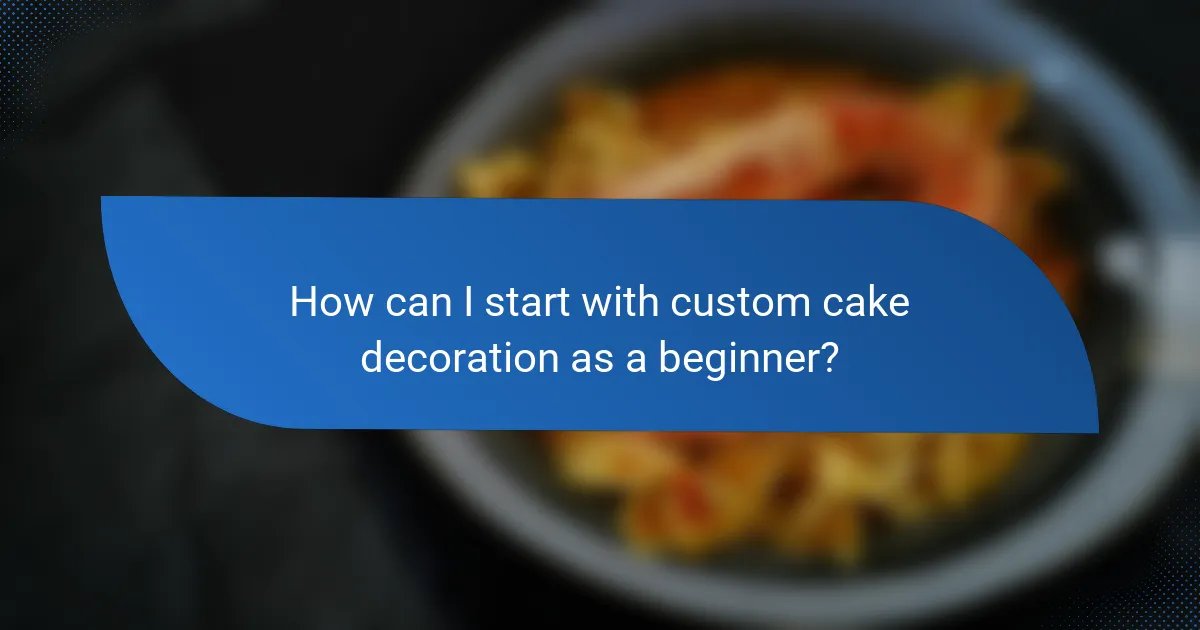
How can I start with custom cake decoration as a beginner?
Start with custom cake decoration by gathering essential tools and materials. Purchase basic supplies like cake pans, spatulas, and food coloring. Familiarize yourself with different icing types, such as buttercream and fondant. Practice basic techniques like smoothing and piping on dummy cakes. Explore online tutorials and classes for visual guidance. Experiment with simple designs before advancing to complex patterns. Join baking communities for support and inspiration. Gradually build your skills through practice and feedback.
What are the first steps to take when decorating a cake?
The first steps to take when decorating a cake include gathering supplies and preparing the cake. Start by choosing your decorating tools, such as spatulas, piping bags, and tips. Ensure the cake is completely cooled to prevent melting icing. Trim any domed tops for a flat surface. Apply a crumb coat to seal in crumbs and create a smooth base. Chill the cake briefly to set the crumb coat. These foundational steps are essential for a successful decoration process.
How do I prepare my cake for decoration?
To prepare your cake for decoration, start by ensuring it is completely cooled. A warm cake can cause melting of frosting or decorations. Next, trim any domed tops to create a flat surface. This helps in achieving an even layer for decoration. Then, apply a crumb coat, which is a thin layer of frosting that seals in crumbs. This step prevents crumbs from mixing into your final layer of frosting. Chill the cake for about 30 minutes after applying the crumb coat. Chilling helps to set the frosting, making it easier to apply the final layer. Finally, once chilled, apply your desired frosting and decorations. Following these steps ensures a smooth and professional-looking cake for decoration.
What techniques should I learn first for effective decoration?
Start with basic piping techniques for effective cake decoration. Mastering piping allows you to create borders, flowers, and lettering. Next, learn fondant application for a smooth, professional finish. Understanding color theory is also essential for choosing complementary shades. Additionally, practice using cake tools like spatulas and molds. These foundational skills enhance your decorating proficiency. Research shows that beginners benefit from focusing on these core techniques first. This approach builds confidence and creativity in cake decoration.
What common mistakes should beginners avoid?
Beginners should avoid overcomplicating designs. Simple designs often yield better results. Many new decorators try intricate patterns too soon. This can lead to frustration and mistakes. Another common mistake is neglecting to plan ahead. Sketching a design can help visualize the final product. Beginners often underestimate the importance of quality tools. Using the right tools can significantly affect the outcome. Additionally, not practicing techniques can hinder skill development. Regular practice is essential for improvement. Lastly, beginners frequently overlook the importance of ingredient quality. High-quality ingredients enhance flavor and texture.
How can I prevent my icing from melting or sliding off?
To prevent icing from melting or sliding off, ensure the cake is completely cooled before applying icing. Warm cakes can cause icing to soften and slide. Use a crusting buttercream recipe, which firms up as it sets. This type of icing creates a stable surface that adheres better. Additionally, chill the decorated cake in the refrigerator for at least 30 minutes. This helps the icing to firm up and stay in place. Avoid using too much liquid in your icing, as excess moisture can lead to melting. Lastly, keep the cake in a cool environment, away from direct sunlight or heat sources. These steps help maintain the integrity of your icing during display and serving.
What should I do if I make a mistake while decorating?
If you make a mistake while decorating, assess the error immediately. Identify what went wrong, such as smudged icing or misplaced decorations. For smudged icing, gently scrape it off with a spatula. Then, reapply icing smoothly. If decorations are misplaced, carefully remove them and reposition as needed. Utilize tools like a toothpick for precision. In some cases, adding decorative elements can cover up mistakes effectively. Always keep extra supplies on hand to facilitate quick fixes. This approach allows for adjustments without starting over completely.
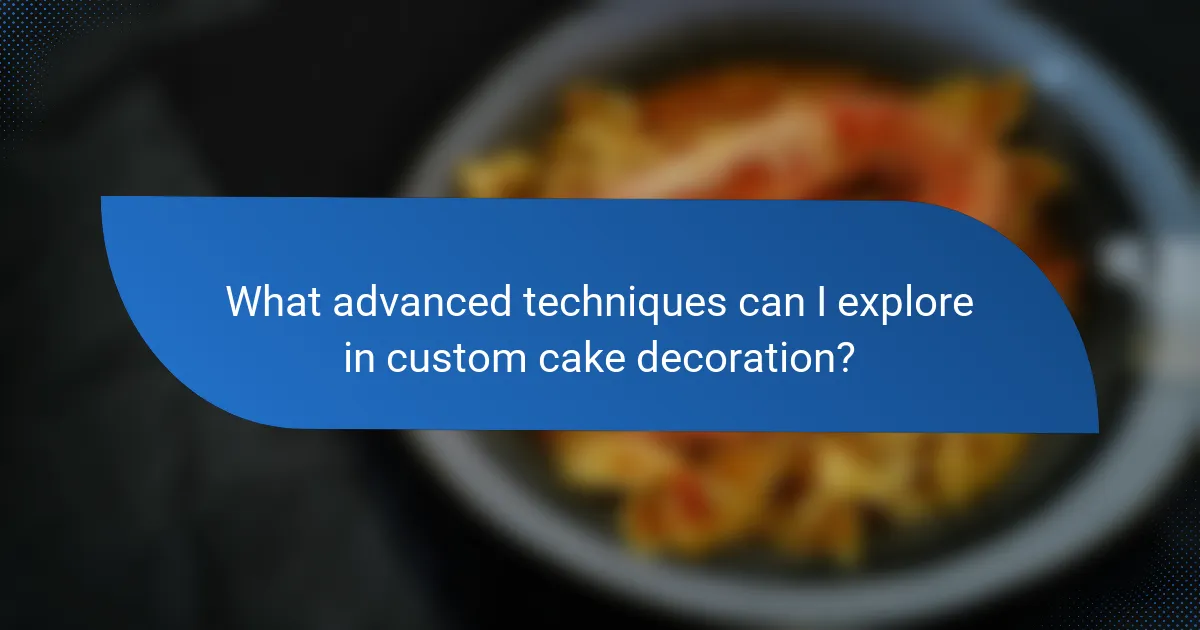
What advanced techniques can I explore in custom cake decoration?
Explore advanced techniques such as airbrushing, fondant sculpting, and sugar flower crafting in custom cake decoration. Airbrushing allows for smooth gradients and intricate designs. It creates a professional finish that is visually appealing. Fondant sculpting enables the creation of 3D figures and detailed decorations. This technique offers versatility in design and texture. Sugar flower crafting involves making realistic edible flowers. These flowers can enhance the overall aesthetic of the cake. Other techniques include piping intricate designs and using edible lace for delicate details. Each technique requires practice and skill development for mastery.
How can I incorporate fondant into my cake designs?
To incorporate fondant into cake designs, start by rolling out the fondant to a thickness of about 1/8 inch. Use a smooth surface and a rolling pin for even results. Next, cover the cake by draping the rolled fondant over it. Smooth the fondant down with your hands or a fondant smoother to eliminate air bubbles. Trim the excess fondant at the base of the cake for a clean finish. You can also use fondant to create decorations such as flowers, ribbons, or figurines. These can be shaped using fondant tools or molds. Additionally, fondant can be tinted with food coloring to match your design theme. Using fondant enhances the cake’s appearance and provides a smooth texture for decorations.
What are the steps to properly roll and apply fondant?
To properly roll and apply fondant, start by preparing your work surface with a light dusting of cornstarch or powdered sugar. This prevents sticking. Next, knead the fondant until it is smooth and pliable. Use a rolling pin to roll the fondant into an even layer, about 1/8 to 1/4 inch thick. Ensure the fondant is large enough to cover your cake.
Once rolled, gently lift the fondant using the rolling pin and place it over the cake. Smooth the fondant down from the top to the sides using your hands or a fondant smoother. Trim any excess fondant at the base of the cake. Finally, use a sharp knife or pizza cutter for a clean edge. These steps ensure a smooth and professional finish.
How can I create intricate designs using fondant?
To create intricate designs using fondant, start by kneading the fondant until it is pliable. Use a rolling pin to roll it out to an even thickness. Cut shapes using cookie cutters or a knife for detailed designs. Employ silicone molds for complex patterns and textures. Use edible dust or airbrush color for added depth and detail. Attach pieces with water or edible glue for stability. Practice techniques like ruffling or pleating for added elegance. These methods enhance the visual appeal of your cake decorations.
What are some creative decoration ideas for themed cakes?
Creative decoration ideas for themed cakes include using fondant to create intricate designs. Fondant can be shaped into flowers, characters, or patterns. Edible glitter adds sparkle and visual interest to cakes. Fresh fruits and berries can enhance both flavor and aesthetics. Themed cake toppers made from plastic or edible materials can personalize the cake. Piping techniques with buttercream can create borders or designs. Chocolate ganache can provide a glossy finish and rich flavor. Lastly, using colored sprinkles or edible confetti can add a festive touch. Each of these ideas enhances the cake’s theme and overall appeal.
How can I personalize a cake for special occasions?
To personalize a cake for special occasions, choose a theme that reflects the event. Incorporate specific colors that match the occasion’s palette. Use decorations such as fondant shapes or edible images that represent the guest of honor. Add a personalized message on the cake, using icing or cake toppers. Consider including favorite flavors of the recipient to enhance the personal touch. Custom molds can create unique shapes relevant to the occasion. Lastly, adding personal items like photos can make the cake more memorable. Personalization enhances the emotional connection to the cake, making it a standout feature of the celebration.
What are some trending themes for custom cake decoration?
Some trending themes for custom cake decoration include floral designs, geometric patterns, and minimalist aesthetics. Floral designs often feature intricate sugar flowers and vibrant colors. Geometric patterns utilize shapes like triangles and hexagons for a modern look. Minimalist aesthetics focus on simplicity, using clean lines and limited colors. Other popular themes are vintage, inspired by classic styles, and themed cakes based on popular culture. Seasonal themes, such as winter wonderland or summer fruits, also remain in vogue. These trends reflect current consumer preferences for personalization and artistic expression in cake decoration.
What tips can help beginners improve their cake decoration skills?
Practice basic techniques consistently. Beginners should start with simple piping and spreading techniques. Use a turntable for even icing application. Invest in quality tools like spatulas and piping bags. Experiment with different icing types, such as buttercream or fondant. Study online tutorials for visual guidance. Attend local baking classes for hands-on experience. Gather feedback from peers to identify areas for improvement.
How can practice enhance my decorating techniques?
Practice enhances decorating techniques by improving skills and boosting creativity. Repeatedly applying techniques leads to muscle memory. This allows for more precise and confident movements. Consistent practice helps in mastering various tools and materials. It also encourages experimentation with different styles and designs. Over time, practice aids in developing a unique decorating style. Studies show that skill improvement is directly linked to practice frequency. For example, the 10,000-hour rule suggests that extensive practice leads to expertise.
What resources or communities can I join for support and inspiration?
Join online communities like Cake Decorating Subreddit and Facebook groups focused on cake decoration. These platforms provide support and inspiration from fellow decorators. Websites like Wilton and Cake Central offer tutorials and forums for sharing ideas. Local baking classes and workshops can also foster connections and enhance skills. Additionally, Instagram and Pinterest are rich sources for visual inspiration and trends in cake decoration.
Custom cake decoration is the focus of this comprehensive guide aimed at beginners. It covers essential tools and materials needed for effective decoration, techniques for preparing cakes, and common mistakes to avoid. The article also explores the evolution of cake decoration, cultural influences, and advanced techniques for enhancing skills. Additionally, it provides creative ideas for themed cakes and personalization for special occasions, ensuring a thorough understanding of the art of custom cake decoration.
